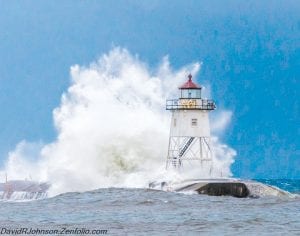Large waves pummeled the break wall and gave the Coast Guard lighthouse a nice bath last week as high winds from the south kicked up the lake, sending water crashing onto the shore and the road leading to the Coast Guard station. The following day the beach and vegetation bordering the beach were covered in ice, making many opportunities for photographers to take pictures like the one Dave Johnson made for the weather picture on this page.

A major winter storm cut into a large swath of land across the Northland on Sunday, Christmas Day and Monday, giving many visitors an extra day to visit family and friends as they waited out the weather until the roads were safe for travel.
Minnesota Department of Transportation (MNDOT) plow trucks were out in force on Highway 61, plowing, salting and sanding. But despite MNDOT’s efforts, MNDOT recommended no travel in northwestern Minnesota through Monday. Cook County plow trucks and Grand Marais crews worked long shifts over the Christmas holiday, making certain main roads were passable and safe to drive.
Lightning flashed through the sky around midnight on Christmas. A light rain and freezing drizzle pelted the ground and buildings throughout the evening as a hard, heavy wind blew in from the south.
Monday, December 26, the wind let up in the morning as more rain fell in Grand Marais. Over the hill, it snowed. During the afternoon snow accumulated to more than six inches from Koochiching County along the border to Grand Portage. Gusts of wind reached 50 mph, causing some blowing and drifting of snow and causing vehicles to swerve or lose control. Visibility was one-quarter mile or less.
On the Gunflint Trail snow and ice conditions made for dangerous driving conditions, with many of the smaller roads off of the Gunflint rendered impassable. The weight of snow and ice on tree limbs and power lines produced outages.
Boxing Day was light at Joynes as few people ventured from their homes to return that sweater that didn’t fit them or that duplicate game. Traditionally the day after Christmas is called Boxing Day in Canada because people return to stores to exchange Christmas gifts. Not this year, though.
Overnight temperature dipped into single digits on Monday night. Tuesday saw sunny skies and temps in the high teens with temperatures pushing into the mid 20s. MnDOT still had driver alerts out on Tuesday.
“We have applied 730 tons of salt, 310 tons of salt/sand mix and we haven’t finished calculating how much salt brine and magnesium chloride we have applied,” said Chris Cheney, MnDOT D1 operations superintendent. “We’ve had every truck out there since the storm began and even had a few breakdowns, but our mechanics were able to get the trucks fixed so they are out there now too.”
Cheney said the storm was a tough one and that the continuous wind has added to the compaction by creating “blow ice.” Blow ice forms after snow blows over a roadway and sticks to the surface.
Cheney said that he expects road conditions will improve by tonight, but advises motorists to check 511. mn.org for the latest-up-to-date travel conditions.
“Our plow operators were committed to keeping the highways as safe as possible during this storm, which hit hardest Christmas Eve and Christmas Day,” said Cheney. “Many of them missed their Christmas dinners or squeezed them in between shifts so they could try to have the roads in good shape for the public to get home safely.”


Leave a Reply